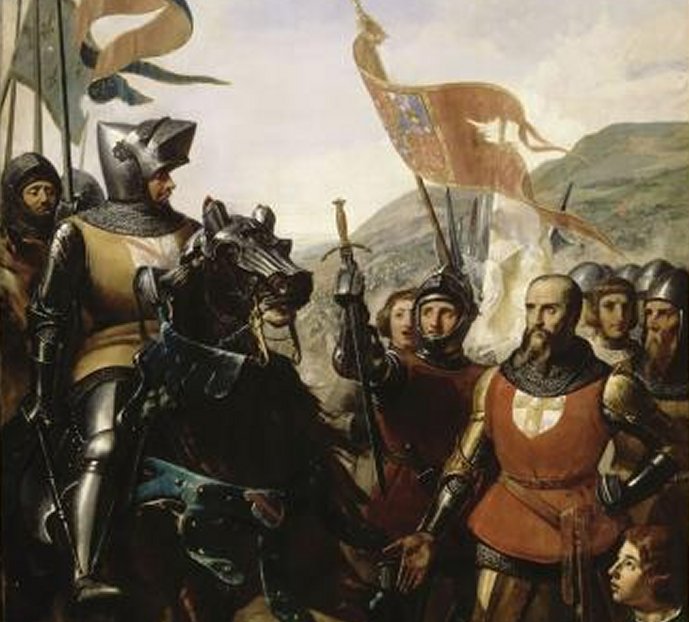Bertrand du Guesclin: ‘Eagle Of Brittany’ Brave, French Commander And His Clash With Sir Thomas Of Canterbury
A. Sutherland - AncientPages.com - Bertrand du Guesclin (c. 1320 – 1380) was the son of a poor knight from Brittany. He was known by nicknames: "The Eagle of Brittany" or "The Black Dog of Brocéliande."
Guesclin at the Battle of Cocherel. Image credit: Charles-Philippe Larivière - CC BY-SA 3.0
Bertrand had not a happy childhood, mainly because he early learned to hate his violent father.
This man wasn't a handsome man. He was far from the kind of man we usually think of as a knight, at least in appearance. Everyone who met him seemed to agree on his unique ugliness. His body was short-grown and square-shaped, and his head was more than usually round. His arms were disproportionately long.
Bertrand And His Trusty Companions In Brocéliande Forest
In the 1340s, the Duchy of Brittany was plagued by a victorious civil war. The old duke's half-brother Charles de Blois, and his niece Jeanne de Penthiévre raved about who could take over.
Jeanne gathered a large group of fighters who would act as guerrilla warriors. Among them was also Bertrand du Guesclin. He bought enough weapons and armor for a smaller group of reliable men by selling his mother's jewels.
Bertrand and his trusty companions hid in the Brocéliande Forest, a legendary enchanted forest that, among medieval Europeans, was imagined as a place of magic and mystery. The forest was believed to be somewhere in Brittany, but its location was never established. Probably the site was only a product of human imagination.
Merlin and Viviane in Brocéliande, Gustave Doré's illustration for Idylls of the King (1868). source
The knight, Bertrand du Guesclin, reminds us of Robin Hood, a legendary heroic outlaw, and a highly skilled archer and swordsman.
Bertrand, however, was an actual historical figure. With his band of fighters, he organized quick and effective attacks, returning safely to his hiding place in the forest.
Bertrand - Military Commander
Bertrand was a Breton knight and an important military commander, who was involved in the Breton War of Succession (1341–1364), Castilian Civil War (1351 - 1369), and the Hundred Years War (1337-1453).
From 1370 to his death, he was Constable of France for King Charles V. King Charles V was particularly impressed with Bertrand's resistance to the English in the siege of Rennes and took him into royal service.
Bertrand was a good and intelligent commander, but not all his military encounters with the enemy succeeded.
He was well known for his Fabian strategy, avoiding regular field battles, harassing the English troops through what is called modern guerrilla warfare, and effectively disrupting supplies of the enemy. He made a famous military career through sheer fighting skills.
He often took part in battles, where the fighting location and time were determined earlier, and won the four in which he held command. Despite many years of military service, Bertrand was dubbed a knight at the unusually high age of 34.
Incident With Sir Thomas Of Canterbury
In 1356, Bertrand was sent to the town of Rennes, which the Duke of Lancaster besieged. The English knight, Sir Thomas of Canterbury, captured Bertrand's little brother during a truce. Such an act was against the rules of war, and Bertrand immediately rode straight into the English camp. When Bertrand entered his tent, Sir Thomas was playing chess with an English knight, Sir John de Chandos. The brave Frenchman challenged Sir Thomas to a sword duel, and the latter didn't protest.
Statue of Bertrand du Guesclin in Dinan. Source
He was convinced that he would defeat this strange-looking intruder. Sir Thomas was wrong.
Bertrand did not add any other life-threatening injuries to his opponent, but he drew attention to his extraordinary sword-fighting skills. During the next half hour, however, he got into so much trouble that he could not go on for several days after this most unfortunate encounter with Bertrand, the knight.
Then he returned home with his abducted brother.
Bertrand was given many assignments, and many of them were victorious. In the Battle of Navarrete in 1367, for example, he was defeated by the Black Prince, a military genius who was a talented warrior. Often captured, then redeemed, Bertrand was known for his boldness and handled well the hostile captivity that he experienced frequently.
In 1380, however, he returned to the French king's service to fight the English but died on July 13. Bertrand du Guesclin was buried, on the command of King Charles V, in Saint-Denis, the burial ground of the French kings.
He was a highly skilled commander whose military capabilities contributed to France's successes, so he deserved an honorable royal burial.
Written by – A. Sutherland - AncientPages.com Senior Staff Writer
Updated on April 29, 2023
Copyright © AncientPages.com All rights reserved. This material may not be published, broadcast, rewritten or redistributed in whole or part without the express written permission of AncientPages.com
Expand for referencesMore From Ancient Pages
-
 Mysterious Ancient Spiral Structure And Buried Towers Discovered At Angkor Wat
Archaeology | Dec 9, 2015
Mysterious Ancient Spiral Structure And Buried Towers Discovered At Angkor Wat
Archaeology | Dec 9, 2015 -
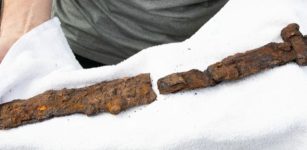 Man Finds A Viking Sword In His Garden – A Viking Grave Could Also Be Nearby – Scientists Say
Archaeology | Sep 2, 2022
Man Finds A Viking Sword In His Garden – A Viking Grave Could Also Be Nearby – Scientists Say
Archaeology | Sep 2, 2022 -
 Mysterious Balkåkra Disc – Rare Strange Bronze Artifact Found In A Bog
Artifacts | Jul 25, 2019
Mysterious Balkåkra Disc – Rare Strange Bronze Artifact Found In A Bog
Artifacts | Jul 25, 2019 -
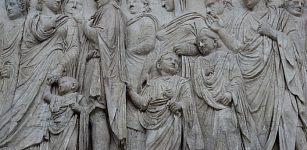 Ara Pacis: Altar In Rome Dedicated To Pax, The Roman Goddess Of Peace
Ancient History Facts | Apr 4, 2016
Ara Pacis: Altar In Rome Dedicated To Pax, The Roman Goddess Of Peace
Ancient History Facts | Apr 4, 2016 -
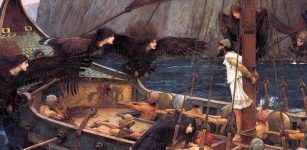 Sirens: The Secret Of The Power In Their Captivating Song That Heralded Death
Featured Stories | Jul 9, 2023
Sirens: The Secret Of The Power In Their Captivating Song That Heralded Death
Featured Stories | Jul 9, 2023 -
 Atlit Yam – Fate Of The 9,000-Year-Old Underwater Megalithic Site With A Huge Stone Circle
Featured Stories | Jun 14, 2021
Atlit Yam – Fate Of The 9,000-Year-Old Underwater Megalithic Site With A Huge Stone Circle
Featured Stories | Jun 14, 2021 -
 230,000-Year-Old Human Remains Discovered In Eastern Africa – Rewrite Ancient History
Archaeology | Jan 14, 2022
230,000-Year-Old Human Remains Discovered In Eastern Africa – Rewrite Ancient History
Archaeology | Jan 14, 2022 -
 Hidden Carving Of Stonemason Never Meant To Be Seen Discovered In Cathedral Santiago De Compostela
News | Nov 2, 2020
Hidden Carving Of Stonemason Never Meant To Be Seen Discovered In Cathedral Santiago De Compostela
News | Nov 2, 2020 -
 Japan’s Ancient Practice Of Cranial Modification: The Case Of The Hirota People In Tanegashima
Archaeology | Aug 18, 2023
Japan’s Ancient Practice Of Cranial Modification: The Case Of The Hirota People In Tanegashima
Archaeology | Aug 18, 2023 -
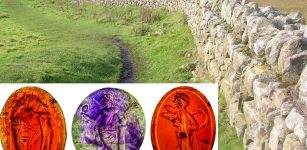 Amazing 2,000-Year-Old Engraved Roman Gems Discovered Near Hadrian’s Wall
Archaeology | Jan 30, 2023
Amazing 2,000-Year-Old Engraved Roman Gems Discovered Near Hadrian’s Wall
Archaeology | Jan 30, 2023 -
 Controversial Artifacts No One Wants To Examine Thoroughly: Is There Something We Are Afraid Of Discovering?
Ancient Technology | May 22, 2019
Controversial Artifacts No One Wants To Examine Thoroughly: Is There Something We Are Afraid Of Discovering?
Ancient Technology | May 22, 2019 -
 What Is A Mural Of Tepoztēcatl, Aztec Rabbit God Of Alcohol Doing In A Mexican Church?
Archaeology | Oct 15, 2022
What Is A Mural Of Tepoztēcatl, Aztec Rabbit God Of Alcohol Doing In A Mexican Church?
Archaeology | Oct 15, 2022 -
 Breakthrough – First Glimpse Into A 2,000-Year-Old Charred Herculaneum Scroll
Linguistic Discoveries | Feb 7, 2025
Breakthrough – First Glimpse Into A 2,000-Year-Old Charred Herculaneum Scroll
Linguistic Discoveries | Feb 7, 2025 -
 Study Traces DNA Of Inca Emperors To Their Modern-Day Descendants
Archaeology | May 29, 2018
Study Traces DNA Of Inca Emperors To Their Modern-Day Descendants
Archaeology | May 29, 2018 -
 Magnificent Ancient Rock-Cut Lycian Tombs Of Myra, Antalya, Turkey
Civilizations | Aug 9, 2015
Magnificent Ancient Rock-Cut Lycian Tombs Of Myra, Antalya, Turkey
Civilizations | Aug 9, 2015 -
 Tantalus – Greek King And Evildoer Who Violated Divine Laws And Was Sent To Tartarus
Featured Stories | Mar 1, 2019
Tantalus – Greek King And Evildoer Who Violated Divine Laws And Was Sent To Tartarus
Featured Stories | Mar 1, 2019 -
 How Ramesses II Became The Greatest Pharaoh In Egypt
Featured Stories | Jun 6, 2021
How Ramesses II Became The Greatest Pharaoh In Egypt
Featured Stories | Jun 6, 2021 -
 Mystery Of The Sphinx – A Guardian Of Knowledge And Symbol Of Riddles And Intrigue
Ancient Mysteries | Oct 13, 2015
Mystery Of The Sphinx – A Guardian Of Knowledge And Symbol Of Riddles And Intrigue
Ancient Mysteries | Oct 13, 2015 -
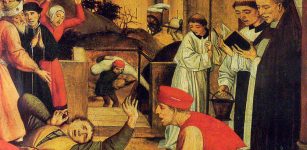 Justinianic Plague Struck England Before It Reached Constantinople And It Did Not Wipe Out The Roman Empire
Archaeology | Nov 19, 2021
Justinianic Plague Struck England Before It Reached Constantinople And It Did Not Wipe Out The Roman Empire
Archaeology | Nov 19, 2021 -
 St. Swithin’s Day And The 40 Days’ Weather Prophecy
Featured Stories | Jul 15, 2023
St. Swithin’s Day And The 40 Days’ Weather Prophecy
Featured Stories | Jul 15, 2023

